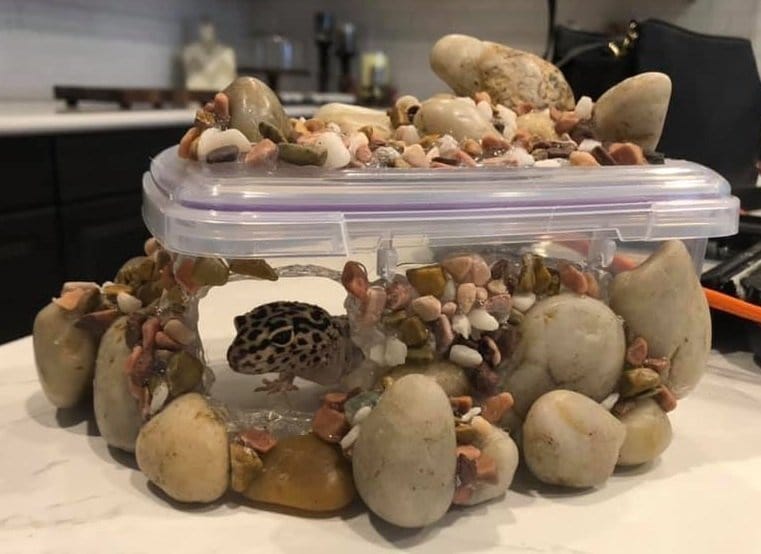
Ideally, you should provide your gecko a 12-hour light and 12-hour dark cycle. Leopard geckos require a specific lighting schedule to maintain their natural circadian rhythms. Use a thermostat to control the temperature, and choose a belly heat source like an under-tank heater or a heat mat, to ensure your gecko’s comfort. Set up a heat gradient across the enclosure, providing a warm side with temperatures around 88-92☏ (31-33☌) and a cooler side with temperatures around 75-80☏ (24-27☌). Provide at least two hides: one dry hide for resting and a humid hide to assist with shedding.Ĭlimbing structures, such as branches, cork bark, and rocks, help promote natural behaviors and provide mental and physical stimulation.Ĭreating the Perfect Environment Temperature and Lighting

Leopard geckos require various hides and climbing structures to feel secure and comfortable in their environment. Choose hardy plants that can thrive in the gecko’s environment, such as succulents, pothos, and snake plants. Plants assist in maintaining humidity and can provide natural hiding spots for your gecko. Incorporating live plants into your leopard gecko’s bioactive terrarium adds to the aesthetics and functionality of the enclosure. These organisms work together to break down organic matter and keep the enclosure clean, reducing the need for frequent maintenance. The clean-up crew typically consists of isopods, springtails, and earthworms. Clean-Up CrewĪ bioactive setup requires a clean-up crew to break down waste and maintain a healthy environment. The substrate should be 3-4 inches deep and promote beneficial microorganisms’ growth while allowing the clean-up crew to do their job. Combine a mix of organic matter, such as coconut coir and sphagnum moss with sand and soil. The substrate is the foundation of your gecko’s bioactive enclosure. This layer should be about 2 inches deep and can be separated from the substrate with a layer of mesh. You can create a drainage layer using solid rocks or hydroton. Drainage LayerĪ proper drainage layer is crucial for maintaining moisture levels and preventing the substrate from becoming saturated. Essential ComponentsĬreating a bioactive environment for your leopard gecko involves several important elements. This, in turn, contributes to a healthier, more stable ecosystem for your leopard gecko to live in. Introducing different species of live plants, clean-up crew insects, and other microorganisms creates a more dynamic and thriving habitat. Lastly, bioactive setups can foster increased biodiversity. This is particularly important for their overall health, as it aids in hydration, shedding, and digestion. Natural Temperature and Humidity RegulationĬreating the right environment in your bioactive setup also helps maintain the proper temperature and humidity levels. This means you’ll spend less time cleaning your gecko’s habitat and more time enjoying their company. With the addition of clean-up crew insects like isopods and springtails, you’ll have a natural cleaning system that helps break down waste. With a bioactive setup, your gecko will feel more at home in its surroundings. In this self-sustaining environment, you’ll have a variety of natural elements such as live plants, substrates, natural hiding spots, and clean-up crew insects, which your gecko can explore and interact with.

This provides mental stimulation for your Leo.

Mimics Natural EnvironmentĪ bioactive tank replicates a gecko’s natural environment. Layering the substrate can support plant life and promote the growth of beneficial microorganisms.Ĭreating a bioactive environment for your leopard gecko brings many advantages compared to traditional non-bioactive enclosures. The substrate should consist of a mixture of soil, sand, and mulch. This includes elements such as live plants, microfauna (small invertebrates), and a bioactive substrate. You want to create an arid bioactive vivarium. The goal is to create a self-sustaining ecosystem that benefits both the gecko and the environment within the enclosure. It simply means designing your tank to mimic your leopard geckos natural habitat. Insufficient Hides and Enrichment What is a Bioactive Terrarium?.Step-by-Step Leopard Gecko Bioactive Tank Setup.Natural Temperature and Humidity Regulation.


 0 kommentar(er)
0 kommentar(er)
